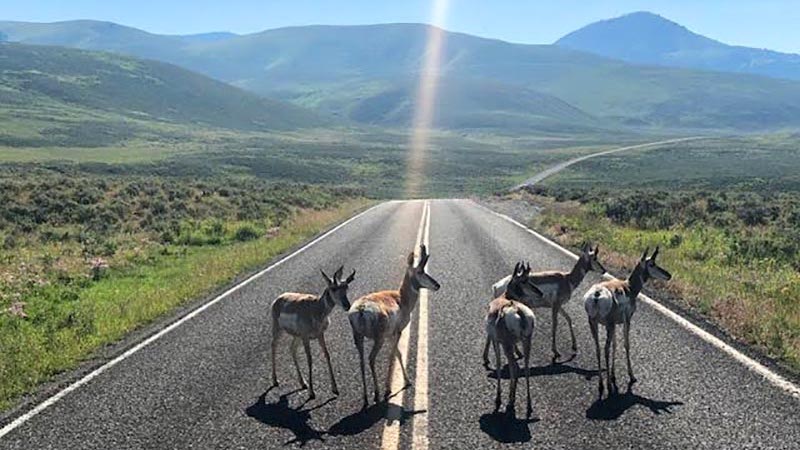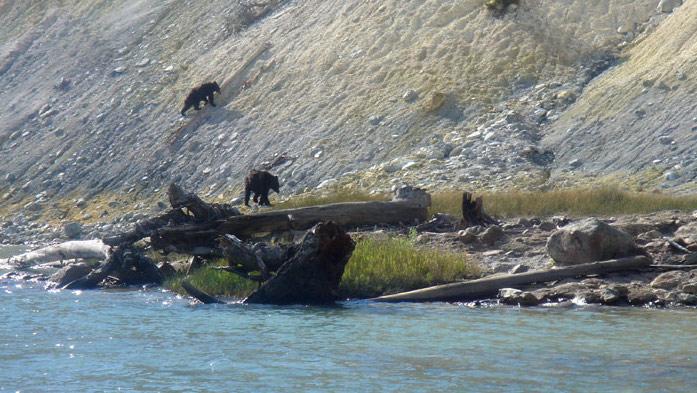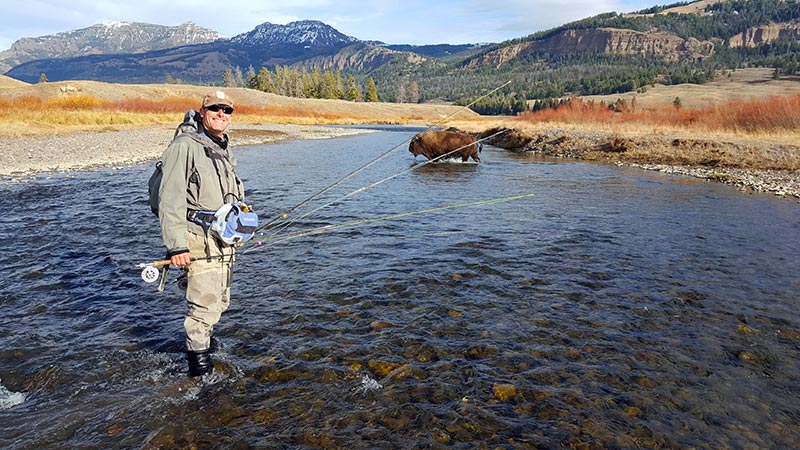Anglers from around the world benefit from and enjoy Yellowstone National Park’s famous rivers like the Firehole, Madison, Gibbon, Slough Creek, Lamar, Soda Butte, and of course the Yellowstone. Our first national park offers anglers endless opportunities throughout the summer and fall; from beautiful native Yellowstone Cutthroat to large fall browns, here you are sure to find some of the best fish the West has to offer. Whether you are looking to fish close to the road, or prefer to hike into Yellowstone’s pristine backcountry, our guides are prepared to show you the trip of a lifetime.
There is no better way to experience the Park than to be catching native cutthroat trout while a herd of peaceful bison stroll by. In general, the best fishing takes place in hard to find, “off the beaten path” areas. You might get lucky and find one of these spots on your own through exploring, but by booking a guide you are guaranteed to find these secret “stash waters.” Many of our favorite spots require a 2-6 mile round trip hike. Die-hard anglers who are in good shape might even opt for a 10-mile round trip. During the summer we like to focus on the North Eastern section of the park, primarily fishing for native cutthroat trout, as the water in this section of the park stays colder and is refreshing for both anglers and trout alike.

A Yellowstone National Park fishing permit is required for anglers over 16 years old. State fishing licenses are not valid and aren’t required.
Three-day permit: $40
Seven-day permit: $55
Season-long permit: $75
You can purchase them in the shop or online at recreation.gov
More info on Yellowstone National Park fishing regulations can be found here: https://www.nps.gov/yell/planyourvisit/fishing.htm
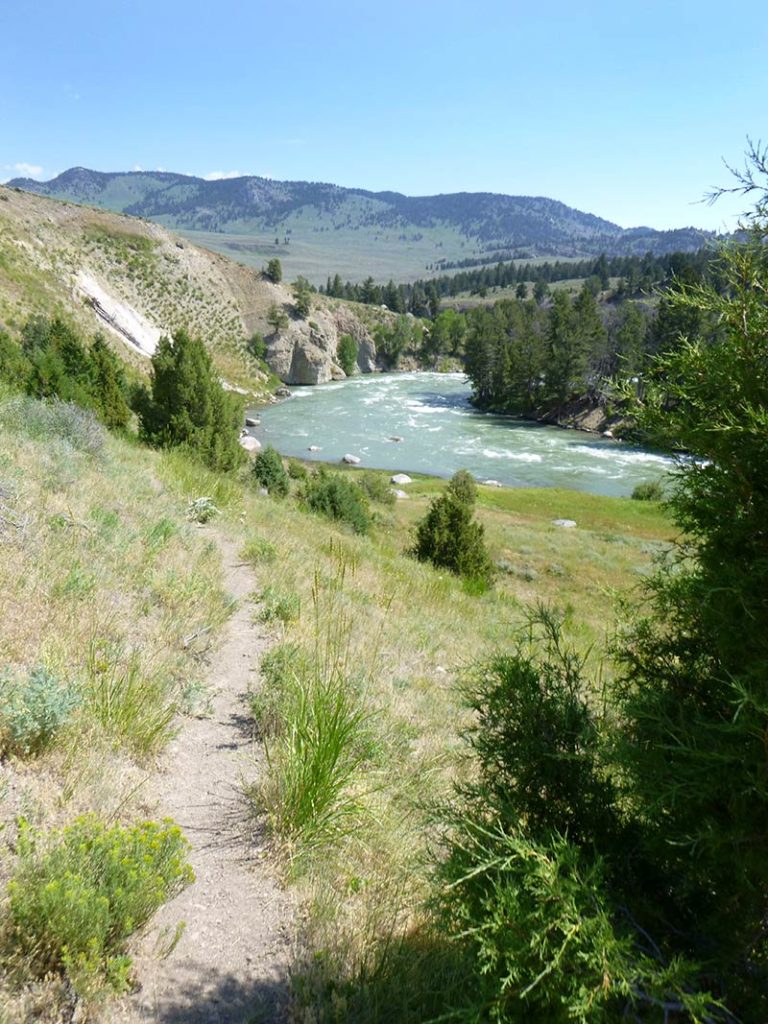
The same mighty Yellowstone River that flows through Paradise Valley and Livingston originates in Yellowstone National Park. Two tributaries, one from Yount’s Peak (12,156 ft) and one from Thorofare Mountain (12,058 ft) come together to form the Thorofare of the Yellowstone, which flows into Yellowstone Lake. This pristine portion of the Yellowstone is difficult to get to without horses, as it requires a hike over 15 miles one-way.
The section that we guide starts below the lake, (although there are a couple of sections here that a permanently closed), down to the confluence of the Yellowstone and the Gardner River, near Gardiner, MT. After the runoff, (usually ending by early July), the river is swarmed with salmon flies and other stoneflies. Terrestrial fishing on the Yellowstone is good in July, August, and September. Depending on how far you’re willing to hike, you can fish parts of the river with very little fishing pressure. The Yellowstone River in the park, like all other streams within the park boundary, is walk wade only.
Dubbed the “strangest trout stream on Earth,” the Firehole River is one of the Park’s fly fish only streams. This spring-fed river gets its name from its course through the most active geyser basins in Yellowstone Park. Anglers are often fishing in a blanket of steam rising from gurgling hot springs. From opening day in the Park, (the Saturday of Memorial Day weekend), until about the end of June, the Firehole provides superb dry fly fishing during hatches of Baetis, Pale Morning Dun mayflies, stoneflies, and several kinds of caddis. The slow-moving (but very tricky) currents in this meadow stream demand careful presentations and realistic imitative flies. Due to the Firehole’s close location to West Yellowstone, (and the fact that when the Park opens, the NE section is still in runoff), these trout see a lot of fishing pressure and become very selective. Similar to the spring creeks, small tippet sizes and matching the hatch perfectly are keys to success.
The hot springs along the Firehole raise the water temperature enough that fishing quality falls off in July and August. As soon as the water cools off again in the fall, trout move back into the Firehole from the colder tributary streams and the fishing picks up once again. The Baetis hatches in late September through October make for some very pleasant dry fly fishing if you can brave the unpredictable weather. The park is much higher country than Livingston and can be much colder. Some of the best hatches come off on those snowy days though, and by this time most of the tourist anglers have departed. But the practical end of the fishing season often comes with the first big snowstorm that closes all the roads for the season. Otherwise, the fishing season in YNP closes during the first Sunday in November.
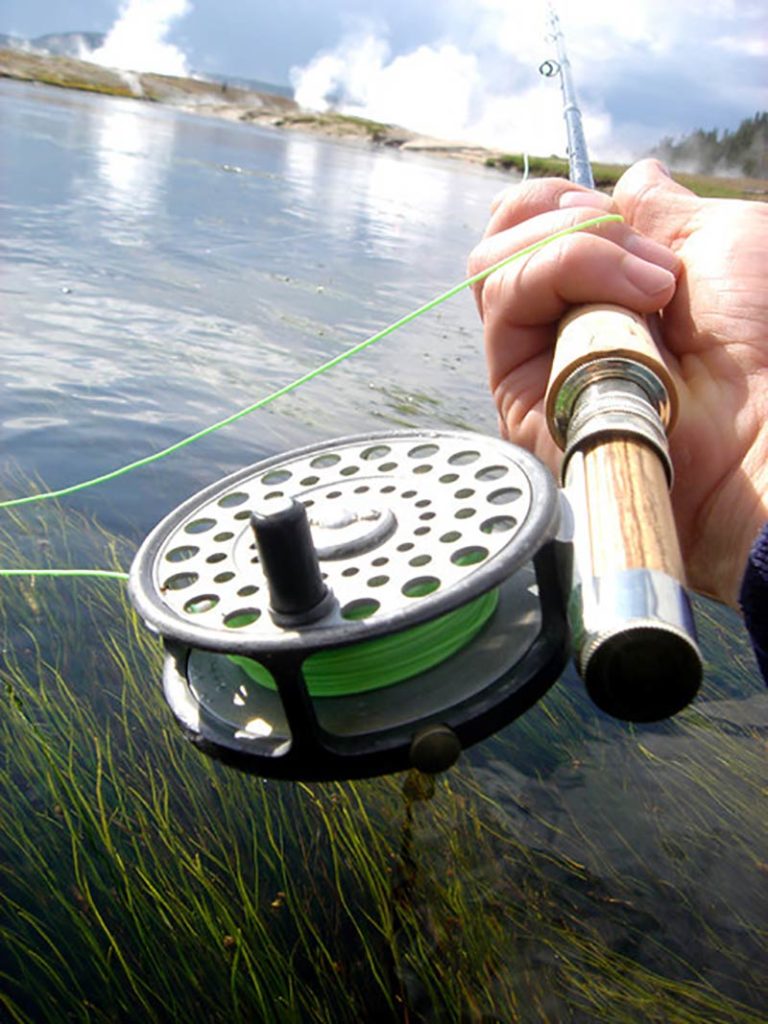

Slough Creek is one of the most popular fishing areas in Yellowstone Park—and for good reason. The scenery is spectacular, access is relatively easy, and the cutthroat fishing is some of the best in the world. The lower meadows of Slough Creek below the campground are easily accessible from parking areas between the campground and the Cooke City road. There are a few big rainbows in this lower water as well as big cutthroat. The upper meadows of Slough are accessed from a trailhead near the campground. The first meadow is a 45-minute walk from the trailhead—this hike starts with a fairly steep climb but levels out after the first hill. Be sure to keep your eyes and ears peeled- the trail is used for horse-drawn wagons headed into the Silver Tip Ranch.
The first meadow is the most popular because it’s close, and while the fishing is excellent, you can expect to see plenty of other anglers here in the middle of summer. If you want to see fewer people, Slough Creek’s second meadow is about a 2-hour trek, but worth the extra effort. The additional distance cuts down the number of anglers, but it also shortens the fishing day if you plan to do this as a day trip. There are several campsites in the second and third meadows but these are on a reservation basis only with the Park Service at Mammoth. Be sure to plan ahead, the earlier you can reserve a campsite, the better. Many of the cutthroat you’ll catch in the second or third meadow will hit 18 and even 20 inches. These are heavy fish, and some of the best fighting cutthroat anywhere! Best of all, they favor rising to dry flies with an almost slow-motion take. Heavy hatches of caddis, PMD’s, and large Green and Grey Drake mayflies make for some spectacular dry fly fishing in July. Later, hoppers, beetles, and flying ants are the winning dry flies.
The Lamar is another favorite Yellowstone Park destination of our guides. The Lamar Valley is one of the most scenic areas in the Park. The river meanders through a grassy meadow, with gentle riffles, boulders, and undercut banks providing some great cover for trout. Elk, bison, bears, and even wolves frequent the Lamar Valley. Expect to see mostly Yellowstone cutthroat trout, although there are some big rainbows and cut-bows in the lower stretch of the river. There are good hatches of Pale Morning Duns, Green and Gray Drakes, as well as a variety of caddis in July. The hopper fishing is excellent from late July through late September. On the right days, the Lamar also produces heavy hatches of Gray and Green Drake mayflies. These are big bugs, size 10 and 12, and tend to bring up all the big fish. If you hit the right day (heavy cloud cover is ideal), you will likely see some of the best dry fly fishing of the whole season.

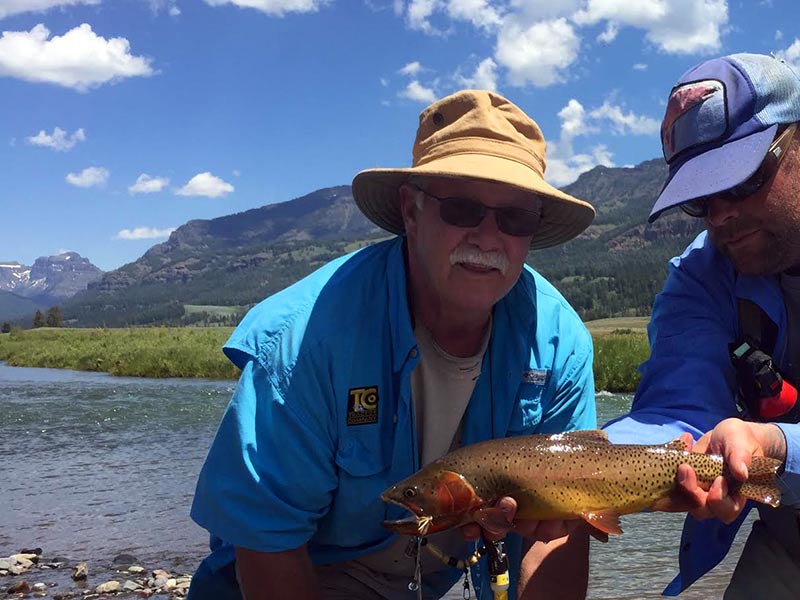
Soda Butte is hailed as one of the best trout streams in Yellowstone National Park. It is similar to the Lamar and runs in between grassy meadows and timber forests. Terrestrial fishing in starts in July and is effective much of the season. There are healthy Pale Morning Dun and Green and Gray Drake hatches through the summer, with good caddis hatches also. In the later season, you can catch the legendary cutthroat on larger drakes and hoppers. Fishing on Soda Butte is some of the most scenic fishing in the park, and access can be fairly easy. The most popular spot is the confluence with the Lamar River, but your guide will take you to a spot where you will be successful. Eat your lunch on the banks of the river and watch bison graze in front of one of the most spectacular backdrops around.
Yellowstone encompasses 3,468.4 square miles (2.2 Million Acres) made up of idyllic lakes, canyons, rivers, forests and mountain ranges. With over 3,000 square miles of land, there is a large portion of rivers and streams that go largely untouched. With many years of exploring and guiding under our belts, we have uncovered some of Yellowstone’s best “No-tell-em” creeks. If your sense of adventure is high and low fishing pressure is what you are looking for, contact us about one of our unforgettable “Hike and Strike” trips. Starting early, you get a chance to see Yellowstone in the quiet calm of the morning, before all the vehicles and people take over. Hike your way through miles of Yellowstone backcountry, and settle in on waters where the fish are just as wild and untouched as the landscape. Our Hike and Strike day trips can be tailored to your specific needs, ranging anywhere from one mile to ten miles. As with all of our park trips, your guide will have bear spray and be experienced in keeping a watchful eye out for signs of bears and other wildlife.
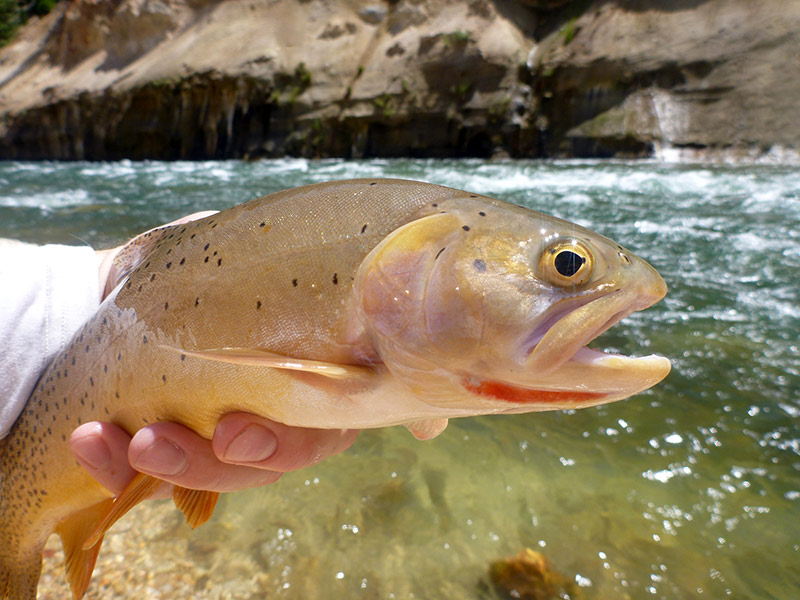
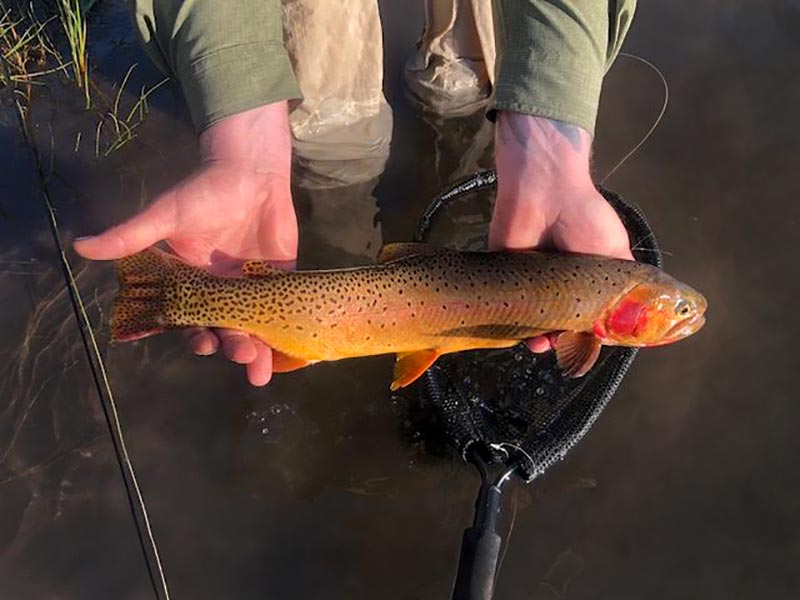
Though Yellowstone is known for its pristine trout streams, there are a few worthwhile lakes to venture to. Trout Lake, in the Northeast Corner, is perhaps the most popular, boasting impressive cutthroat. Lakes can be a great choice for anglers looking to mix up their trip and fish still water. Joffe Lake near Mammoth is a great option for children or beginners. Leeches, scuds, damselfly nymphs, or other streamers work well on these lakes as well as dries such as callibaetis, green and gray drakes, and damselflies.


